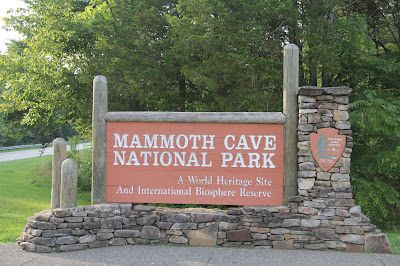It's been a while since there has been a new post on this blog. Regular visitors to this site will probably notice a pattern. I try to publish new posts every week day during the school year and at least three times a week during the summer. However, every year (typically in July), this site goes dark for a week or two while Shara and I go on vacation. This year's trip took us south through Ohio, into Kentucky, and back up through Indiana, Illinois, and into Iowa before returning home to Michigan.
We typically do lots of "science geek" and "history geek" things on our vacations - visiting museums, nature centers, public gardens, historic sites, etc.. Over the next few posts I plan on sharing a few of the highlights.
One of the stops on our trip was at
Mammoth Cave National Park. Mammoth Cave is the world's largest cave system. Currently four hundred five (405) miles of interconnecting passages have been mapped!
Much of the bedrock in Kentucky consists of layers of either sandstone, shale, or limestone. Mammoth Cave (any many other caves found in Kentucky) formed as a result of flowing water dissolving layers of limestone and leaving the shale and sandstone layers behind. Many features in the caves (stalactites, stalagmites, flowstones, soda straws, etc.) form as dissolved minerals in the water are deposited on the ceiling, walls, or floor of the cave.
The National Park Service offers a number of tours in the cave. The tours range in distance from 1/4 mile to 5 miles, and vary in time from 1.25 hours to 6 hours in length. We chose to take one of the shortest options - the Frozen Niagara Tour. This tour takes place at an entrance to the cave system that was created in 1924 to provide easy access to this portion of the cave.
Visitors to the cave are not alone. Other species either live in the caves or use the caves as shelter. Species include eyeless cave fish that are adapted to life in the dark, cave salamanders, cave crayfish, cave crickets, Allegheny Wood Rats (also known as "pack rats"), and bats. The bats hibernate in the cave and are mostly absent during the summer months.
 |
| An Allegheny Wood Rat nest illuminated by our guide's flashlight - the things on the ceiling are cave crickets |
|
 |
| Cave crickets! |
While the animals are cool, the focus of the tour is on the unique geologic features.
Visitors to the cave are asked to not use touch any of the cave's surfaces. Natural oils from human skin can actually disrupt (and stop) the process of mineral deposition. In the past, before the cave became a national park, visitors were allowed to write their name on the ceiling of some portions of the cave. While this "historic graffiti" is preserved, anyone that does this today will be given a hefty fine and potentially receive jail time.
Humans can have another catastrophic effect on the caves. We are a major cause for the spread of
White Nose Syndrome. This fungal disease has killed millions of hibernating bats across eastern North America. Humans spread the disease by visiting caves that are infected and then failing to properly decontaminate before visiting other caverns. The spores from the fungus travel along with us and infect bats in the new cave. After leaving Mammoth Cave, visitors are required to walk across disinfecting mats to treat their shoes with a fungicide.
 |
| Shara in her #Save the Bats t-shirt from the Organization for Bat Conservation |
Mammoth Cave is located about eight hours from Mid-Michigan and could easily be visited during a long weekend excursion. If you want to take one of the cave tours it is recommended that you reserve a space on the tour ahead of time - some of the tours sell out.
 |
| I don't have a cool #Save the Bats t-shirt (yet) |

















































